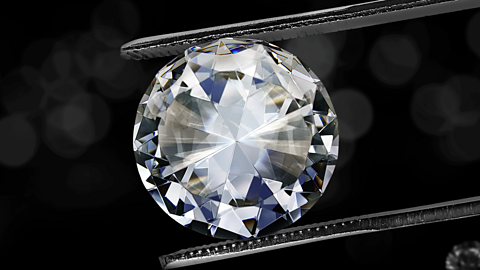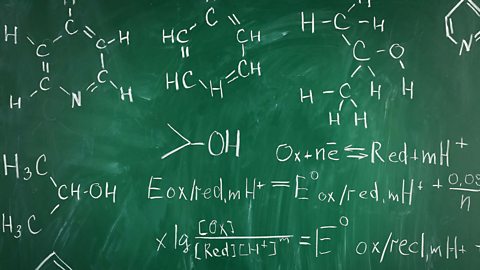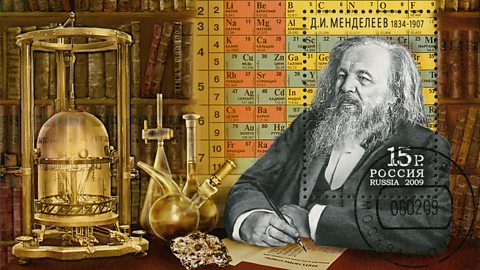What are the key learning points about structure?
- Structure describes how atomThe smallest particle of an element. We often think of atoms as tiny spheres, but in fact they are made from smaller particles called protons, neutrons and electrons. are arranged once they have bonded together.
There are 4 main categories of structure:
ionic bondAn ionic bond is the attraction between oppositely charged ions. substances have a giant ionic latticeA regular grid-like arrangement of atoms in a material.structure, with a large repeating pattern of oppositely charged ionElectrically charged particle, formed when an atom gains or loses electrons..
covalent bondA covalent bond is formed by a shared pair of electrons. substances have two different structures: molecular covalent and giant covalent.
metallic bondThe attraction between delocalised electrons and the positive ions in a regular lattice. substances have a metallic structure, with regular layers of positive ions surrounded by delocalised electronsElectrons that are free to move throughout a whole structure..
What are the different types of structure?
In chemistry, ‘bonding’ describes how atoms are held together.
‘Structure’ describes how atoms are arranged once they are bonded together.
The type of structure depends on the type of bonding.
There are two different structures for covalent bonding.
What are ionic structures?
Giant ionic lattice
When ionic bonding forms between a metal and a non-metal, lots of ions group together to form a giant ionic lattice.
A giant ionic lattice is a three-dimensional structure of oppositely charged ions held together by ionic bonds.
What are the physical properties of ionic compounds?
A physical property describes how a substance behaves.
There are four main physical properties of giant ionic lattices.
| Physical property | Explanation |
|---|---|
| High melting points and boiling points. | A large amount of energy is needed to break the strong ionic bonds between the ions in the lattice. |
| Do not conduct electricity when solid. | The ions are held in fixed positions in the lattice so cannot move and carry charge. |
| Conduct electricity when molten or dissolved in water. | When a lattice is melted or dissolved in water the ions are free to move and carry charge. |
| Most ionic compounds are soluble in water | None required. |
Question
Magnesium and chlorine can react to make magnesium chloride.
Name the type of structure in magnesium chloride.
Explain why magnesium chloride has a high melting point.
Answer
Magnesium is a metal and chlorine is a non-metal.
Therefore magnesium chloride is held together by ionic bonding (metal + non-metal).
Structure is a giant ionic lattice.
It has a high melting point because a large amount of energy is needed to break the strong ionic bonds between the magnesium and chloride ions in the lattice.
What are covalent structures?
Covalent bonding forms substances with two types of structures:
Molecular covalent structures. Simple molecule A collection of two or more atoms held together by chemical bonds. held together by weak forces of attraction. Examples include iodine, methane and carbon dioxide. This is the most common type of covalent structure.
Giant covalent structures. Many atomThe smallest particle of an element. We often think of atoms as tiny spheres, but in fact they are made from smaller particles called protons, neutrons and electrons. joined together by strong covalent bonds. At GCSE the examples are diamond, graphite and graphene.
The atoms in a molecular covalent structure are held together as molecules by strong covalent bonds.
There are weak intermolecular forces between different molecules.
These weak forces are called van der Waals' forces and can be broken with a small amount of energy.
What are the physical properties of molecular covalent structures?
| Physical property | Explanation |
|---|---|
| Low melting points and boiling points. | A small amount of energy is needed to break the weak van der Waals’ forces between the molecules. |
| Do not conduct electricity. | The molecules are neutral so there are no ions or delocalised electrons to carry charge. |
| Most molecular covalent substances are insoluble in water. | None required. |
Question
Hydrogen chloride (HCl) has a melting point of -114oC.
This is much lower than the melting point of calcium chloride (CaCl2), which has a melting point of 772oC.
Explain the difference in melting points.
Answer
Hydrogen chloride: two non-metals = molecular covalent structure.
Hydrogen chloride has a low melting point as it takes a small amount of energy to break the weak van der Waals’ forces between the molecules.
Calcium chloride: metal + non-metal = giant ionic lattice structure.
Calcium chloride has a high melting point as a large amount of energy is needed to break the strong ionic bonds between the calcium and chloride ions in the lattice.
What are giant covalent structures?
A giant covalent structure is a three-dimensional structure of atoms that are joined together by lots of strong covalent bondA covalent bond is formed by a shared pair of electrons..
Carbon is a non-metal element that can form three different giant covalent structures: diamond, graphite and graphene.
A carbon atom can form up to four covalent bonds.
Diamond, graphite and graphene are examples of allotropes.
Allotropes are different forms of the same element, in the same physical state.
Diamond

Diamond is a giant covalent structure in which each carbon atom is covalently bonded to four other carbon atoms in a tetrahedralA bonding shape where four bonds are spread out in a pyramid pattern., three-dimensional structure.
Diamond’s properties include:
| Physical property | Explanation |
|---|---|
| High melting points and boiling points. | A large amount of energy is needed to break the many strong covalent bonds between the carbon atoms. |
| Does not conduct electricity. | Diamond has no ionElectrically charged particle, formed when an atom gains or loses electrons. or delocalised electronsElectrons that are free to move throughout a whole structure. that can carry charge. |
| Very hard. | Diamond has strong covalent bonds arranged in a rigid tetrahedral structure. |
Diamond is used in cutting tools for drilling through hard materials like rock and glass.
Graphite
Graphite has a giant covalent structure in which:
- each carbon atom forms three covalent bonds with other carbon atoms
- the carbon atoms form layers of hexagonal rings
- there are weak forces of attraction between the layers
- there is one, non-bonded delocalised electron for each carbon atom
Graphite’s properties include:
| Physical property | Explanation |
|---|---|
| High melting points and boiling points. | A large amount of energy is needed to break the many strong covalent bonds between the carbon atoms. |
| Conducts electricity. | Each carbon atom has a delocalised electron that is free to move through the layers and carry charge. |
| Soft. | There are weak forces between the layers so the layers can easily slide over each other. |
Graphite is used as a lubricantAny substance which reduces friction between two surfaces. and in pencils.
In pencils, the layers of carbon atoms can slide over each other and onto the paper.
Graphene
Graphene is a single-atom thick layer of graphite with strong covalent bonds between each carbon atom.
The atoms are arranged in hexagons.
Graphene’s properties include:
| Physical property | Explanation |
|---|---|
| High melting points and boiling points. | A large amount of energy is needed to break the many strong covalent bonds between the carbon atoms. |
| Conducts electricity. | Each carbon atom has a delocalised electron that is free to move and carry charge. |
| Very strong. | Contains many strong covalent bonds. |
| Transparent. | Only a single atom thick. |
Graphene is used in batteries and solar cells due to its good electrical conductivity.
What is metallic structure?
Metallic structure consists of regular layers of positive metal ionElectrically charged particle, formed when an atom gains or loses electrons. surrounded by delocalised electronsElectrons that are free to move throughout a whole structure..
The delocalised electrons are free to move throughout the structure.
What are alloys?
An alloy is a mixture of two or more elements, at least one of which is a metal.
The mixture has metallic propertiesThe properties of a substance are the qualities and characteristics of a substance that describe and identify it..
Alloys are therefore harder than pure metals.
They have metallic structures, but having different sized atoms in the structure makes it more difficult for the layers of ions to slide over each other.
Gold
The gold used for jewellery is alloyed with other metals, often silver, copper or zinc.
This strengthens the jewellery while maintaining its shine.
The proportion of gold in the alloy is measured in carats.
24 carat gold is pure gold, while 18 carat gold is 75% pure gold.
The following equation can be used to calculate the percentage of gold in an alloy from a carat rating:
\(\%~gold~=~\frac{carat~rating}{24}~X~100\)
Question
Calculate the percentage of gold in an 18 carat gold coin.
Answer
\(\%~gold~=~\frac{carat~rating}{24}~X~100\)
\(\%~gold~=~\frac{18}{24}~X~100~=~75\%\)
How to classify structures in chemistry
Chemistry exam questions often provide data about a range of substances and ask students to classify them as an ionic latticeThe regular arrangement of ions in an ionic substance., molecular covalent structuresSimple molecules held together by weak forces of attraction. Examples include iodine, methane and carbon dioxide. This is the most common type of covalent structure. , giant covalent structuresMany atoms joined together by strong covalent bonds. Examples are diamond, graphite and graphene. or metallic structures.
| Structure | Melting point | Solubility in water | Electrical conductivity |
|---|---|---|---|
| Giant ionic lattice | High | Soluble | Conductive when molten or dissolved |
| Molecular covalent | Low | Insoluble | Not conductive |
| Giant covalent (diamond) | Very high | Insoluble | Not conductive |
| Giant covalent (graphite and graphene) | Very high | Insoluble | Conductive |
| Metallic | Usually high | Insoluble | Conductive |
Order it
Test your knowledge
More on Unit 1: Structures, trends, chemical reactions, quantitative chemistry and analysis
Find out more by working through a topic
- count4 of 10

- count5 of 10

- count6 of 10

- count7 of 10
